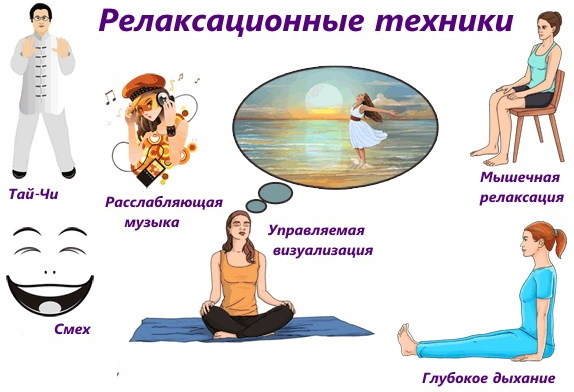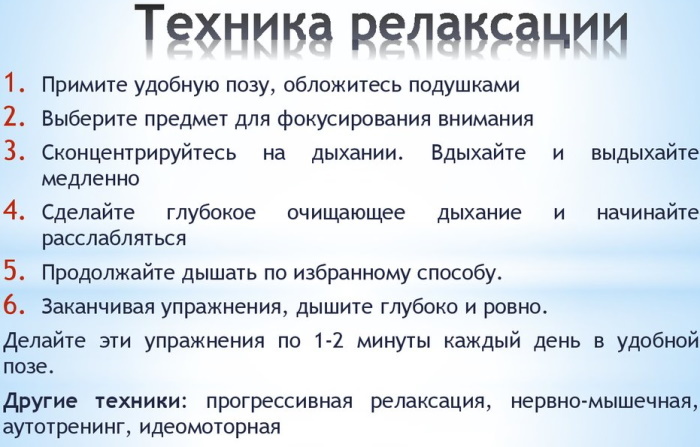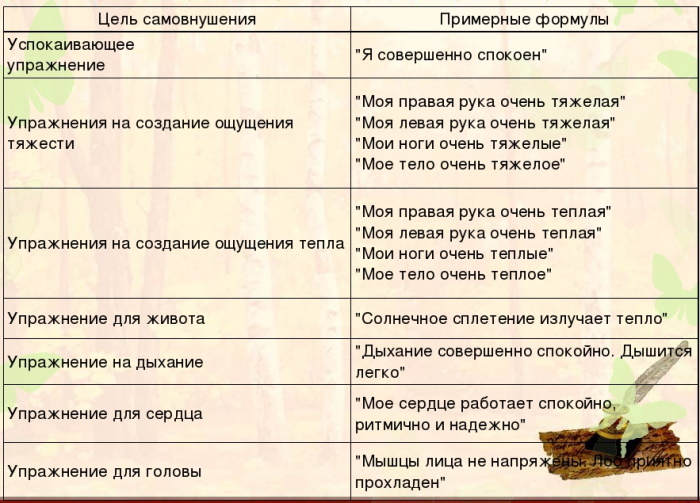Content
- What is auto-training, what is treated with it
- How often can the training be applied?
- Auto-training action
- Preparation for the lesson, conditions
- Situation
- Music
- Poses
- Relaxation techniques
- Correct breathing
- Muscle relaxation
- Visualization
- Entering the alpha state
- Implementation of the training
- Relaxation
- Severity
- Warmly
- Self-hypnosis
- Basic auto-training exercises
- Breath control
- Verbal impact on the subconscious
- Muscle tone management
- Heart rate alignment
- Warming the solar plexus
- Types and techniques of auto-training for anxiety-depressive states
- To calm the nervous system
- For self-confidence
- For sleep
- With VSD
- Against anxiety
- With neuroses
- results
- Auto-training video
Auto trainings are specially designed exercises for independent work with various aspects of the destructive functioning of the nervous system. They are performed in order to normalize the psycho-emotional background. Learn more about how to use these exercises to tune in to productive work in any anxiety-depressive states, described later in the article.
What is auto-training, what is treated with it
Self-training (or autogenic training) is a versatile relaxation technique that can be easily learned and used without the assistance of a specialist. This workout is a set of mental exercises that, depending on the need, help to achieve body relaxation and reduce anxiety and depression.
Self-training was developed by the psychiatrist Johann Schulz in 1932 as a means of self-regulation against anxiety, deterioration in concentration and any mental disorders. Schultz divided auto-training into 2 stages: the lower stage, aimed at relaxation, and the higher one - the introduction of the patient into a deeply relaxed state, bordering on the state of trance or sleep. Recently, the Schultz technique has been changed by therapists for different purposes.
Today, with the help of auto-training, psycho-emotional states are treated and restored:
- prevention of neuroses and psychosomatic disorders;
- self-regulation against panic attacks and excessive anxiety;
- reduction of mental and physical stress;
- regulation of heart rate and breathing deepening;
- reducing pain by abstracting and switching attention;
- fighting stress and fear;
- reduction of obsessive states.
To achieve the effect of auto-training, depending on the problem, you may need either one session or long-term work with your own subconscious.
How often can the training be applied?
Auto-training has both preventive and curative effects on the psyche and the human body. Exercise can be done every day to increase concentration, or to switch between activities.

Auto trainings for anxiety-depressive states are performed both on an ongoing basis and for simple relaxation. For a more noticeable result, exercises should be performed for 2-3 weeks every day. Such a regime will allow you to develop the necessary habit of relaxing and suppressing destructive thoughts. The best option for classes is every day for 5 - 10 minutes, in the morning and in the evening.
Auto-training action
Auto trainings for anxiety-depressive states are used as methods of restoring physical and psychoemotional sensation through two-stage tranquility: physical relaxation of the body and visualization desired.
Self-training is an effective way of self-hypnosis, which has a psychological effect on a person's condition, his nervous and the cardiovascular system, as well as cognitive abilities: managing concentration, motivation and self-discipline.
Preparation for the lesson, conditions
For a beginner, auto-training usually takes a lot of time to prepare. Reaching the required level of relaxation is a matter of time and practice. To get the desired effect from auto-training, you need to prepare.
For this you need:
- find a quiet place;
- take a comfortable position;
- decide what to concentrate on.
 The first stage is relaxation of the body. There are many different techniques for this, from the cumbersome Schultz relaxation system to the lighter ones. The auto-training itself begins after deep relaxation. It feels like a state of deep relaxation - between light sleep and wakefulness.
The first stage is relaxation of the body. There are many different techniques for this, from the cumbersome Schultz relaxation system to the lighter ones. The auto-training itself begins after deep relaxation. It feels like a state of deep relaxation - between light sleep and wakefulness.
Situation
For the successful completion of auto-training, it is necessary to find a calm environment, comfortable enough so that it is neither cold nor hot. External stimuli such as noise, cold, heat or bad air can interfere with the quality of the auto-training for relaxation.
Music
One of the ways to effectively relax and immerse yourself is to accompany the auto-training with calm and pleasant music. Therefore, beginners are often advised to resort to this method of relaxation. It can be anything from classics to nature sounds, or an accompanying relaxation meditation.
Poses
The main principle of body position during auto-training is to be comfortable and the person does not feel numbness or spasms. Therefore, it is more often advised to posture lying or reclining, with an emphasis on relaxing the back.
You can also sit in a chair, having previously aligned your back. During the session, the arms and legs should not be crossed so that the limbs do not become numb. In a sitting position, it is also important to monitor the position of the head so that during relaxation it does not stretch the neck and does not create unnecessary tension and inconvenience.
Relaxation techniques
The relaxation techniques of auto-training are very simple, everyone can learn them.
The main key to success in this case is the implementation of the recommendations of each basic element:
- correct breathing;
- muscle relaxation;
- visualization.
Correct breathing
Breathing in auto-training exercises can be both the main tool for calming the nervous system, and initial relaxation with subsequent switching to other exercises. Breathing correctly during auto-training means the following: take 3-4 times as deep as possible inhale and exhale at the beginning exercise, and then passively observe the breathing process without trying to make it more intense during auto-training.
Muscle relaxation
Muscle relaxation is an important part of auto-training: verbal self-hypnosis or visualization can be missed, but relaxation of the whole body is an indispensable part of helping to reduce tension in both the body and thoughts. The most common muscle relaxation technique in auto-training is the full-body sequential scan described in the basic exercises below.
Visualization
Visualization is another auto-training technique that can help reduce anxiety and stress. For visualization to be effective, it must be performed after deep muscle and mental relaxation. From the point of view of auto-training, visualization is a technique of the 2nd stage of relaxation.
In order for the visualization to have the maximum effect, it is necessary to follow such basic recommendations as:
- present the desired picture in the head, using sensory perception: present sensations, joy, temperature and other aspects that will make the visualization as real as possible;
- present the situation in the first person;
- do not doubt their own abilities, in the state of visualization everything is possible.
 Thus, visualization allows you to train resistance to stress and quickly recover from setbacks and shocks.
Thus, visualization allows you to train resistance to stress and quickly recover from setbacks and shocks.
Entering the alpha state
The alpha state is a stage of the brain that describes a relaxed state of mind and body (the next stage of theta rhythms is already inherent in the stage of deep sleep). In psychology, entering the alpha state means reducing the activity of the brain, stopping thinking, or imagining something (the stage of active work of the brain is called the beta state).
Entering alpha in auto-training is important for 2 reasons. Firstly, it is in the alpha state that a person relaxes, and secondly, at this stage it is possible to effectively influence the nervous system and subconsciousness.
Implementation of the training
Carrying out auto-training can vary from the cumbersome step-by-step training described by Schultz to easier and faster psychotherapy exercises in the form of visualization, relaxation, meditation and cognitive exercise. The main task of auto-training is to switch attention from a stress factor (thoughts, problems or pain).
The most common elements of auto-training that allow you to distract yourself are 4 components:
- relaxation;
- severity;
- warmly;
- self-hypnosis.
Relaxation
There are many formulas for relaxation in auto-training - all of them are designed for a comfortable individual approach. Prolonged, but unobtrusive concentration on one's own body helps to disconnect from everyday problems and plans, calm the mind, and go directly to auto-training exercises.
Despite the different variations of the relaxation exercise, one basic principle operates here: relaxation occurs in relation a separate part of the body (each arm and leg separately, also separately the shoulders, forearms, hands, fingers, neck, head and all parts head).
Severity
The next important sensation during relaxation is conscious heaviness (at the beginning only 40% of practitioners feel it), which is felt in the limbs - in the arms, elbows or legs. This heaviness may in some way resemble a slight numbness and cause a desire to move. It is advisable not to do this, the impulse to change the position will quickly pass. Body heaviness indicates a transition to a deeper state of cognitive, mental and physical relaxation.
Warmly
After the state of gravity has become habitual, a pleasant warmth begins to be felt in the body - this is the result of improved blood flow in the limbs. By concentrating on this sensation of warmth, the person sinks even more into a state of calm. After a while, you may notice that the heat begins to be felt evenly - this indicates physical relaxation. At this stage, you can monitor your breathing.
Self-hypnosis
In auto-training, self-hypnosis is often described as the second stage of relaxation, and in some cases is even overlooked.
Self-hypnosis has different forms and methods, depending on the need:
- visualization of intention and purpose;
- verbal affirmations;
- active presentation of the desired images.
Basic auto-training exercises
Self-training can have either one or two stages of exercises. If the first is a relaxation phase, then the second is aimed at doing exercises to reduce various negative states.
Breath control
Breathing exercises are a quick way to relieve anxiety. These simple exercises have an important advantage: they can be performed whenever any discomfort is felt. The most common way is the exercise "Breathing by itself", that is, passive concentration, calm and shallow breathing, without unnecessary effort. Here you can try to identify different sensations during breathing: the pace of inhalation and exhalation, air temperature, rhythms in the body.
This exercise usually takes 5-10 minutes. You can also set a timer so you can fully concentrate on the exercise and not worry about the timing.
Verbal impact on the subconscious
Another effective way of influencing the subconscious is the repeated repetition of positive statements (affirmations).
Such verbal influence is the most familiar way of learning for the brain (since kindergarten, the verbal way of transmitting information is the dominant one). Therefore, repeating certain formulations during deep relaxation, a person effectively puts information into his own subconscious, on the basis of which his new one is formed identity.
Muscle tone management
The main goal of this exercise is to feel the pleasant heaviness that usually comes after muscle relaxation. In addition to the usual technique of mental scanning of the body, part by part, you can increase concentration. phrases such as: "the right hand is getting heavy", "the left hand is getting heavy", "the right leg is getting heavy" and so on Further.
The result of this exercise is paradoxical: after a feeling of heaviness in the whole body, there comes a feeling of peace, lightness and detachment from one's own thoughts.
Heart rate alignment
Auto-training exercises to align the heart rate help to normalize the heartbeat, its rhythm and reduce discomfort after shortness of breath - the main consequences of psycho-emotional stress.
Basic examples of exercises are as follows:
| Exercise title | Description, its purpose |
| "A heart" | the main instrument of this exercise is words. Repeating and mentally realizing such phrases as “my heart beats evenly and calmly”, “I feel warmth in every cell” or “pain decreases ", a person purposefully calms the nervous system and thereby equalizes blood pressure, which reduces the resulting discomfort in chest. |
| "Pulse" | after a few minutes of relaxation, begin to mentally pronounce the following phrases several times; “My heart beats evenly”, “my pulse is calm”, “my heartbeat works rhythmically like a clock”. |
| "Rib cage" | in a state of relaxation, it is necessary to repeat the sentence 4 times: "Nothing bothers me, I am calm and at ease, in the chest area I am warm and pleasant." After each pronunciation, it is important to pause and listen to your own feelings, focus on breathing, inhale deeply several times and hold the air. |
The ability to even out the heart rate after any unexpected consequences is the key to not only good health, but also a good stress resistance skill.
Warming the solar plexus
The solar plexus is a standard exercise that can help normalize anxiety. In this exercise, after relaxing the whole body, you need to start concentrating on the solar plexus, in the abdomen, 10 cm above the navel.
Passive concentration and observation of breathing in the belly allows you to feel warmth in the solar plexus and distract from negative thoughts. In addition to concentrating on sensations, you can also pronounce statements in your mind: either simply "warmth" or "I have warmth inside."
Types and techniques of auto-training for anxiety-depressive states
Auto trainings for anxiety-depressive states are exercises to maintain the normal state of the nervous system. To get the best results, you need to accurately identify the problem of anxiety. Below are the most common types of exercise to regulate psycho-emotional imbalance.
To calm the nervous system
Self-training can help calm the nervous system in the moment and reduce anxiety due to unconscious fears and panic attacks. In the first case, relaxation exercises should be done for any discomfort for 5 - 20 minutes a day. To reduce unconscious anxiety, auto-training should be performed on a regular basis for 3-4 weeks.
The most effective way to calm the nervous system is a combination of two stages of auto-training: not only muscle relaxation, but also verbal self-hypnosis, affirmations.
For self-confidence
To increase self-confidence with the help of auto-training, you need to perform the exercise in 2 stages: first relax, and then visualize an image of your own success, which you can reinforce affirmations.
For the exercise to be effective, it must be performed regularly for 1-2 weeks, and adhere to such visualization rules as: create not only a mental picture, but also its emotional composite. That is, imagining that you are already a confident person, you need to literally feel that way.
The exercise may seem uncomfortable at first. Such sensations are a natural reaction of the subconscious to a new experience. Therefore, the more and better visualization is, the more confidence will arise inside.
For sleep
Auto trainings can also be used as a way to fall asleep in case of anxiety and depression. To do this, it is enough to perform only the first stage of the exercises, that is, muscle relaxation. This will help to distract from thoughts and switch to bodily sensations. If, after performing a mental scan of the whole body several times, it was not possible to fall asleep, then you can switch to visualizing relaxation in some pleasant place.
With VSD
VSD most often cause discomfort due to headaches, which reduce performance. In this case, auto-training helps to distract from pain. To do this, you need to relax, scanning the entire body, diverting the focus of attention from the sensation of a headache. By doing this exercise for 5-10 minutes, the mind will be able to abstract from the pain, which will diminish its sensation.
Against anxiety
Auto trainings for anxiety-depressive states have a positive effect on reducing anxiety. To do this, it is important to perform two stages of relaxation: first, relax the body, and then - by verbal self-hypnosis, calm the anxious brain.
To reduce anxiety, you need to take a comfortable position, and devote 10-15 minutes to observing your own feelings. By focusing on scanning the body, a person thereby reduces the work of the limbic system of the brain, which is responsible for the development of an anxious reaction to external stimuli.
Then go to the second stage of relaxation, to affiramations, repeating: "I am comfortable", "my body is relaxed", "I I concentrate my efforts on calming the nervous system, my state, "I am in complete control of my psyche." After a few minutes of chanting, the mind will be sufficiently distracted from the problems.
With neuroses
Auto trainings are an effective way to reduce anxiety in case of nerves and other diseases on a nervous basis.
So, for example, if due to the situation there is some kind of discomfort, uncertainty or fear, you can not only relax with auto-training, but also enter the second stage and visualize confidence and a positive outcome situations. What exercises will help expand the perception of a real situation, which is often inaccessible due to negative thinking, which narrows the focus of perception in a state of stress.
results
Self-training is a wide range of cognitive exercises that are effective for various anxiety-depressive conditions.  Performing them regularly, you can reduce the signs of psychoemotional imbalance, reduce the level of anxiety and normalize the nervous system.
Performing them regularly, you can reduce the signs of psychoemotional imbalance, reduce the level of anxiety and normalize the nervous system.
Auto-training video
Autotraining for neurosis, panic attacks and VSD:



